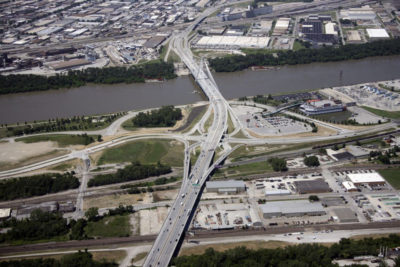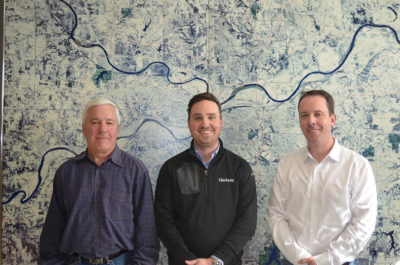Inside a conference room at Clarkson Construction’s office, located below Cliff Drive in Kansas City’s industrial East Bottoms neighborhood, hang a set of photographs.
On the far left is a photograph of G.G. (George) Clarkson, who founded the contracting company that became Clarkson Construction in 1880. In the beginning, G.G. Clarkson used the muscles of men and mules alike to help build homes and basements in Kansas City. Present-day CEO Bill Clarkson refers to the Clarkson’s role in the early years as ‘dirt movers.’ In the middle hangs a wide photograph of Bill Clarkson’s father and grandfather walking under a bridge after the Missouri River flooded in July of 1951. The third photograph features a business card, blown up to fit a frame, for G.G. Clarkson and Sons Grading Contractors. The card shows an address on 3931 St. John Avenue, just a few blocks away from the present-day headquarters of the Northeast News.
The company’s connection to the Historic Northeast community dates back, essentially, to the beginning of Kansas City as we know it. From the beginning, the company has been family-owned and operated; Clarkson Construction is now in its sixth generation. Perhaps that’s one reason why, when the Northeast News inquired about writing a feature on the local construction behemoth, President Bill Clarkson, Jr., Vice President Billy Clarkson, and Chief Engineer Steve Kellerman made themselves available for a sit-down.
“My dad lived right over here by Montgomery Ward’s. It’s the flea market now,” said Bill Clarkson early in the interview. “The house is still there.”
Talking about the company’s history, Bill shared a series of nostalgic memories. Clarkson Construction’s original office, now being utilized as a paint shed, still sits in the back of the company’s sprawling East Bottoms lot. Back in the 1960s, he remembers coming down to the yard and encountering his father’s horse, who lived on the premises. He also shared one of his favorite places to get a view of the lot.

“If you go up on Gladstone Blvd., you can look down and see this whole area down here. You can see the whole panorama,” Bill said, before joking, “I could tell who was at work, too.”
If you’ve been keeping tabs on Kansas City’s push towards a new single terminal airport, you’ve probably heard of Clarkson Construction. They were announced as part of Edgemoor Infrastructure and Real Estate’s winning construction team late last summer, and were frequent visitors to City Hall as a Memorandum of Understanding (MOU) was negotiated between Edgemoor and the City of Kansas City, Missouri. After a series of robust discussions, that MOU was approved on Thursday, February 8. Barring a catastrophic setback before financial close, Clarkson Construction will have boots on the ground at the airport as early as the fall of 2018.
Though the hometown team of Burns & McDonnell didn’t ultimately earn the contract, Kansas City residents should take note that at least one long-time Kansas City company will have a hand in building the airport. Kellerman, for one, acknowledged that with Burns & McDonnell being out front and forward about selling the project to Kansas City, Clarkson’s involvement with Edgemoor took a back seat during the procurement process. If you ask the brain trust at Clarkson Construction, that’s just the way they like it.
“Our approach to responding to the RFQ/P that the City put out was to do our business the way that we always do our business: put the facts down on the proposal that we’re going to put forward, put our best foot forward, make sure that we look at what the City is asking for, make sure that we address those goals in a very no-frills approach, and submit,” said Kellerman. “Ultimately, we ended up where we ended up when the selection committee made their recommendation.”
Clarkson Construction isn’t about to denigrate Burns & McDonnell, either. In their eyes, there might not be a single terminal airport project without the work put in by the firm.
“Everyone’s thankful, from Sly James down, that Burns & Mac came to the table a year ago. We were doing work with Burns & McDonnell; they’re a great firm,” said Bill Clarkson. “I hope they say the same about us. We’re glad they teed it up; they had the foresight to do it.”
Clarkson Construction will not build the new airport terminal, but the company will still have an important role in the project.
“You’ve got to get back to basics. You’ve got to re-route the roads, you’ve got to tear it down, you’ve got to have some foot bridges, you’ve got to have mass grading. That’s what we do,” said Bill Clarkson. “We’ll be the first one’s there, and then the building guys go up. But it’s an important element.”
In addition to the more than 1,500 lane miles of pavement placed by the company over the years, Clarkson has also constructed more than 700 individual bridges and completed more than 800 total projects, while presently juggling more than two dozen ongoing projects. Clarkson employs roughly 45 full-time workers, as well as an additional 325-400 seasonal staff during peak construction months. According to Kellerman, the company’s equipment fleet has an estimated replacement value in the neighborhood of $50 million.

Clarkson Construction has had their hands on a plethora of notable area projects. The original Paseo Bridge – now the Bond Bridge – was built in part by Clarkson Construction from 1952-1954. The company also had a hand in building the Bond Bridge. Another project of note includes the Chouteau Trafficway bridge.
“The Chouteau Bridge that you probably drove over coming down here – we just re-decked that within the last 10 years, probably,” said Kellerman. “I think we built the original one, but that was really a long time ago.”
Other projects of note include the diverging diamond design at Front St. and 435, and work at 210 and 435, the Olathe Gateway shopping center, the Grandview Triangle, both the Kansas Speedway and the Legends shopping center, and the One North development in the Northland.
The wealth of options means that all three members of the Clarkson Construction brain trust have their favorite projects.
For Billy Clarkson, it’s the iconic Bond Bridge.
“I think the coolest one, if that’s what you’re looking for, is probably the Bond Bridge. It’s an actual symbol that people recognize,” Billy said. “For example, and this is a stupid way to recognize it, but if there’s a Chiefs game going on and they’re showing a cut-in of Kansas City, they’ll show the Bond Bridge. I think that’s really cool, because it’s something of an icon in Kansas City.”
For Bill Clarkson, the Grandview Triangle is Clarkson’s most notable work.
“The Triangle. They advertised five jobs over four or five years, and we were fortunate to get four out of the five,” said Bill. “That changed that whole area out there.”
Kellerman pointed to his most challenging project: the Gateway development in Johnson County.
“It was the first design-build project that KDoT ever did. That’s part of what made it a challenge. It was also almost a $300 million project that had a very tight schedule. We built, I think, 29 bridges on that job,” Kellerman said. “I like being able to leave something behind that really impacts the area. We talked about the development growth, but also just leaving a safer way for the public to travel. I think what’s out there now is a vast improvement.”
Once upon a time, Clarkson Construction was known primarily as “Kansas City’s Highway Construction Company.” But the company has worked to expand its portfolio as it has seen Department of Transportation budgets decrease over the years.
“It’s happened twice where the highway funds have gone dormant,” said Bill Clarkson. “If you’re a highway contractor and that’s all you’re doing, you’re just going to be twirling your thumbs, letting people go and downsizing. None of that is fun.”
So the company evolved, chasing work for utility companies and railroads. Now, the company says that it’s work in the private sector stands on its own.
“We’ve always had this private development aspect of our company, but the gas has really only been down when DoT’s are down,” said Billy Clarkson. “So now we’re just trying to stay on top of this so that even when the DoT work comes up, it’s not like we’re pushing this aside. It’s not a fallback option; it’s a main artery.”
Six generations later, Clarkson Construction is still innovating. Their work at Kansas City International will represent another big step, as the local company works on its biggest project yet. Now that the dust has settled and the MOU is signed, the question begs: was there ever a moment when they worried the deal might fall through?
“I don’t know if there was a particular moment; it was a general block of moments,” Billy joked.
Kellerman acknowledged that there were difficult times, but added that Clarkson weathered the process by maintaining focus.
“We stuck with the way we started the whole way through,” Kellerman said. “We had a plan, and we followed the plan.”




















